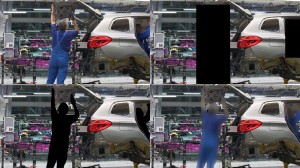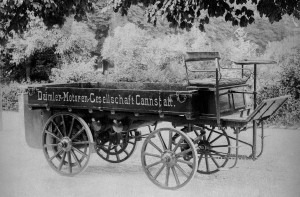

Listen to “AD #3055 – Mary Barra Called a Racist; Big Risk for OEMs Making the Switch to EVs; BMW Helps Improve Image Processing” on Spreaker.
Follow us on social media:
Runtime: 11:56
0:07 GM Accused of Not Doing Enough Business with Black Media
1:17 Chinese EV Startups Have a Good Day
2:02 Traditional Automakers Face Big Risk Switching to Electric
3:09 Cadillac Getting Electric D-Sized Crossover
4:38 Hong Guang MINI EV Gets a New Variant
5:39 BMW Helps Improve Image Processing
6:28 Daimler Lays Claim to First Pickup Truck
7:40 Ranking Traditional OEMs by U.S. BEV Market Share
8:32 Mazda MX-5 Miata Drive Review
10:14 Chrysler Pacifica Stow N’ Go Correction
10:35 Do You Know What Car This Is?
Visit our sponsors to thank them for their support of Autoline Daily: BorgWarner, Bridgestone, Intrepid Control Systems and ZF.
This is Autoline Daily, the show dedicated to enthusiasts of the global automotive industry.
BLACK MEDIA COMPANIES CALL OUT GM
Black owned media companies in the United States are attacking General Motors for not doing enough business with them. They recently took out full page ads in several major newspapers calling GM CEO Mary Barra a racist and demanding she give them more business or resign immediately. GM is trying to tiptoe around the issue, but yesterday media mogul Sean Combs joined in. He posted an open letter saying “If You Love Us, Pay Us.” GM spends about $3 billion a year on advertising. It will not say how much it spends with Black owned media companies, but promised to raise that to 4% next year and 8% by 2025. That’s not good enough for Sean Combs. He says if 15% of a corporation’s revenue comes from Black customers, then it should spend 15% on black owned companies. While GM is the first company to be singled out for its media buy, these media companies promise it’s an issue they’ll raise with all major corporations.
CHINESE EV STARTUPS HAD A GOOD DAY
The Autoline Global Stock index did not move much yesterday. Up only 0.6%. But Chinese EV companies outperformed everyone else. Li Auto and XPeng led the way with gains of 4% or more. With the exception of BYD, the Chinese EV startups are listed on American stock exchanges, either the NYSE or NASDAQ. And now Reuters reports that Didi, which you could call the Uber of China, is also going to list on an American exchange. Why are so many Chinese companies coming to America? There are several reasons, but the main one is access to capital. There’s just a lot more access to capital in the US than there is in China.
| Close | $ Change | % Change | |
|---|---|---|---|
| BYD | $23.00 | +$0.46 | +2.0% |
| NIO | $38.70 | +$1.43 | +3.8% |
| Li Auto | $23.23 | +$1.00 | +4.5% |
| XPeng | $35.45 | +$1.38 | +4.1% |
| Kandi | $6.33 | +$0.11 | +1.8% |
TRADITIONAL AUTOMAKERS FACE BIG RISK SWITCHING TO ELECTRIC
Traditional automakers must place their bets wisely in the switch to electric vehicles. That’s according to a new study from KPMG which says carmakers face a big risk in the transition and that by “getting it wrong by five years, you go bankrupt.” It says global EV sales will make up 24% to 37% of sales by 2030. If EVs reach 30% market share by 2030 that will leave traditional automakers with 40 million ICE vehicles in excess capacity, the equivalent of 200 unneeded plants. It’s a tough balancing act for automakers. If they bet too big and too early on EVs it could risk profits from not having gas powered models. But if they wait too long to make the transition they could get left behind. The study predicts that one or two of the top global automakers will fail to make the switch and that they will cease to exist within the next decade. Who are you placing your bets on?
CADILLAC GETTING ELECTRIC D-SIZED CROSSOVER IN 2024
And speaking of traditional automakers transitioning to an electric future, we’ve got more details about GM’s EV plans. The company has already confirmed that its Factory Zero plant in Michigan will build the Hummer EV truck and SUV, the electric Silverado and the Cruise Origin autonomous shuttle. And now LMC Automotive forecasts that GM will also build the production version of the Cadillac Celestiq at that plant starting in 2023. LMC also says that the first BEV to launch at its Spring Hill plant in Tennessee will be the Cadillac Lyriq next March and that a D-sized Cadillac crossover will go into production in 2024. An electric Escalade? We’ll see. But GM is aiming to sell 1 million BEVs globally by 2025.
POPULAR CHINESE EV GETS NEW VARIANT
China’s best-selling EV, the Hong Guang MINI EV has been so popular it’s getting a new variant, called the Macaron. Updates include new colors, like Avocado Green and White Peach Pink, but also the ability for pretty wild customization. Features that we take for granted are only just being made standard on the Macaron, like a driver airbag, anti-lock brakes, tire pressure monitoring system and low-speed pedestrian warning. If you wondered how it kept prices for the EV so low before, well now you know. The MINI EV is a bit pokey with a top speed of 100 km/h or about 60 MPH and a range of up to 170 kilometers or about 105 miles. But it’s proved to be very popular with younger buyers and the new model seems very affordable as well. Prices range between roughly $5,700 and $6,650.
BMW HELPS WITH IMAGE PROCESSING
BMW is helping out others when it comes to image processing. It’s publishing an anonymization algorithm, which anyone can get access to, that uses AI to block out or blur certain objects in a picture or video. That ability allows developers to train systems that use things like cameras or robots for image processing. For example, areas in BMW’s production plants that contain people are made unrecognizable, so its image processing system can make sure the right part goes on the right car. By publishing algorithms and other source codes, BMW hopes others will use them, make improvements of their own, then republish that and then BMW can get access to those improvements as well.
DAIMLER LAYS CLAIM TO VERY FIRST PICKUP TRUCK
Not only does Daimler claim the first automobile, but also the first truck. Founder Gottlieb Daimler invented this back in 1896, what looked like little more than a fruit cart with a two-cylinder engine that made a whopping 4 horsepower and linked to the rear axle via a belt. But people quickly realized how versatile the vehicles were and changes came fast. In only a few years engine sizes increased and beefier springs were fitted on the back for heavier payloads. I think we know how the story goes from here.
U.S. BEV MARKET SHARE FOR TRADITIONAL AUTOMAKERS
Traditional automakers don’t sell a lot of electric cars. At least not yet. But some are doing better than others. And Porsche is doing the best of all. In the US market over 11% of its sales are battery electrics. Another German luxury maker takes the second spot. Audi. Nearly 8% of what it sells is battery powered. Then there’s a big drop off to Chevrolet. But thanks to the Bolt EV 2% of Chevys are electric. Then Ford, Nissan and Hyundai come in at 1%. We’re still in the early days, so these rankings will change as more EV models come out. Even so, there’s a lot to be said for first-mover advantage. And these brands could emerge as the winners in the race to sell electric cars—at least amongst the traditional automakers.
| Traditional OEM U.S. EV Sales & Market Share Q1 | ||
|---|---|---|
| Porsche | 2,008 | 11.5% |
| Audi | 4,324 | 7.8% |
| Chevrolet | 9,025 | 2.1% |
| Ford | 6,614 | 1.0% |
| Nissan | 2,925 | 1.0% |
| Hyundai | 1,907 | 1.0% |
THE MAZDA MX-5 RF IS A GREAT CAR, IF YOU FIT
That Chrysler Pacifica minivan we reported on yesterday is as big as a whale. Nothing mini about it. So now we go to the opposite end of the spectrum: the Mazda MX-5. If you’re over 6 feet tall, or over 1.8 meters, or if you weigh over 200 pounds, or over 90 kilos, don’t even think of trying to squeeze into this car. It really is a tight fit. It’s one of the key reasons why it doesn’t sell better. This was our first drive in the RF model, which has a retractable roof. Or we should say semi-roof, because only the top of the roof retracts. It’s a slick operation that only requires you to push a button on the console. No latches for you to fumble with. Everything goes and stows automatically to the count of just 13 “Mississippi’s.” But you pay for that convenience. A base MX-5 costs about $28,000, while the RF we drove cost $8,000 more–just under $36,000. Besides, the manual convertible top on the MX-5 has always been one of the simplest and easiest to use, so the retractable hard top is not a whole lot more convenient. But it does create a different look to the car. And it is somewhat quieter on the highway. But that’s all relative because the RF is still a noisy car at highway speeds. Even so, if you’re lucky enough to be able to shoehorn yourself into an MX-5 it is one of the most satisfying cars to drive that any enthusiast could hope for.
CORRECTION TO PACIFICA’S STOW N’ GO FEATURE
And a quick correction from yesterday’s review of the Chrysler Pacifica. A Chrysler spokesperson reached out to let us know that while our Pinnacle AWD version only had Stow N’ Go in the third row, not the second, all other non-hybrid AWD versions of the Pacifica do have the feature in both the second and third row.
DO YOU RECOGNIZE THIS CAR?
OK you automotive detectives, an Autoline viewer needs your help identifying a car. This short video comes from Mr. Dana in Canada who spotted this vehicle while driving through what looks like a lovely countryside. I’m sure this would have been easier with a grille and headlights, but someone out there has got to know it. Leave your thoughts in the comments.
But that’s all we’ve got for this week. Thanks for joining us and have a great weekend.
Thanks to our partner for embedding Autoline Daily on its website: WardsAuto.com

John McElroy is an influential thought leader in the automotive industry. He is a journalist, lecturer, commentator and entrepreneur. He created “Autoline Daily,” the first industry webcast of industry news and analysis.










